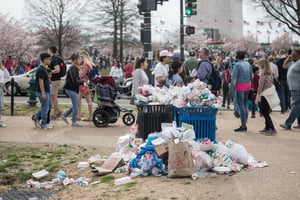 Why didn’t you take out the garbage? It’s overflowing!”
Why didn’t you take out the garbage? It’s overflowing!”
“I thought you were going to take it out.”
“I took it out last time.”
“No, I did.”
Anyone that lives in a multi-person household has probably had to contend with garbage scuffles, often with silent games of Garbage Jenga ensuing: The bin gets close to full…fuller…then begins the careful building of the trash tower.
Each new piece of refuse gets strategically and delicately placed atop the mounting sculpture so as not to send the unsecured litter flittering to the ground. He who fails and tumbles the trashy house of cards must pick up the loose debris and take out the garbage.
Garbage pile-up at this level doesn’t seem too concerning. You work it out, someone promises to be more proactive, maybe you assign chore duties to avoid future fracas. No big deal, the trash gets taken out, and once a week, someone else hauls it away.
The Straw That Broke the Landfill’s Back
But here’s where it becomes a big deal – or rather a big, serious pileup. Our collective ‘trash bins’ are overflowing. Our garbage landfills grow higher and higher and higher…and there’s no other place to take it.
But what about recycling, you say? Though we’ve made great progress in recycling, not everything we continue to produce can be recycled: certain types of glass, paper, and plastic. Things like coffee mugs, diapers, dyed paper, coated juice boxes, plastic screw-on caps, yogurt cups, all get plunked onto the ‘big pile.’
And not everything in your recycling bin gets recycled. Since China has stopped accepting U.S. recyclable “foreign garbage,” much of what could be recycled in the U.S. is now getting dumped into landfills.
Recent Court Ruling Emphasizes Need for Effective R&D Claim Documentation |
The Pacific Northwest alone has relocated more than 2,000 tons of paper to landfills – paper that China could have recycled. Of the 6.3 billion metric tons of plastic waste that we’ve created, only 9 percent was recycled.1 And because plastic takes a creeping 400 years to degrade, it isn’t going anywhere anytime soon.
Currently, most food packaging materials are a conglomeration of glass, paper, metals, and plastics (38%)2, – much of it is not eligible for recycling. Food encasements compromise 23% of all garbage dumps contents and much of the litter floating in our waters.
Put Your Packaging Where Your Mouth Is
But now that consumers have become more aware of the many environmental implications of traditional food containers, they’re demanding sustainably sourced, less polluting materials – and putting their money where their environmental conscience is. In response, food manufacturers have begun to seek acceptable alternatives.
What kind of alternatives? Biodegradable and edible packaging. Food manufacturers have set their research efforts towards developing package materials derived from food ingredients or at least food-grade ingredients.
Local fishermen in Thailand used to wrap their lunches in banana leaves.3 The leaves are biodegradable and could be tossed overboard without environmental repercussions. Though you will probably never find your food jacketed in banana leaves on grocery shelves, researchers are looking at food-based laminate and films that will work much like man-made plastics for food packages.
The research is still very much in its early stages, with scientists and food manufacturers worldwide pursuing this new approach. Already researchers in the Food Packaging Group, Department of Food and Nutritional Sciences, University College Cork, Ireland, have discovered a few worthy edible/biodegradable films.
The Prize Inside
Of course, the research is costly and resource-intensive. Organizations and manufacturing can unwrap federal research and development (R&D) tax credits to help fund their efforts. The government awards a dollar-for-dollar reduction in federal tax liability to businesses that increase research and development activities and spending to invent or improve products, process, techniques, inventions, formulas, or software.
And activities to improve or develop new food packaging possess great potential to qualify for this lucrative tax incentive.
As we play a global game of ‘Trash Tetris’ with our waste products, food manufacturers may be able to take advantage of the government credit to create more environmentally friendly food containers and slow down the pileup on our landfills.
For those researchers and manufacturers who want to ensure they capture their maximum potential credits, help from a tax specialist is paramount.
- A whopping 91% of plastic isn’t recycled, National Geographic, 2018
- Edible/biodegradable packaging for food, New Food, 2019
- Throwaway culture has spread packaging waster worldwide: here’s what to do about it, The Guardian, 2017



